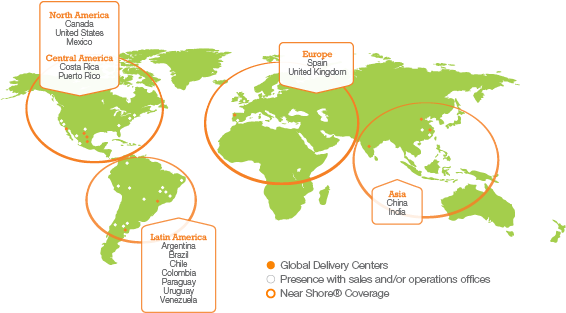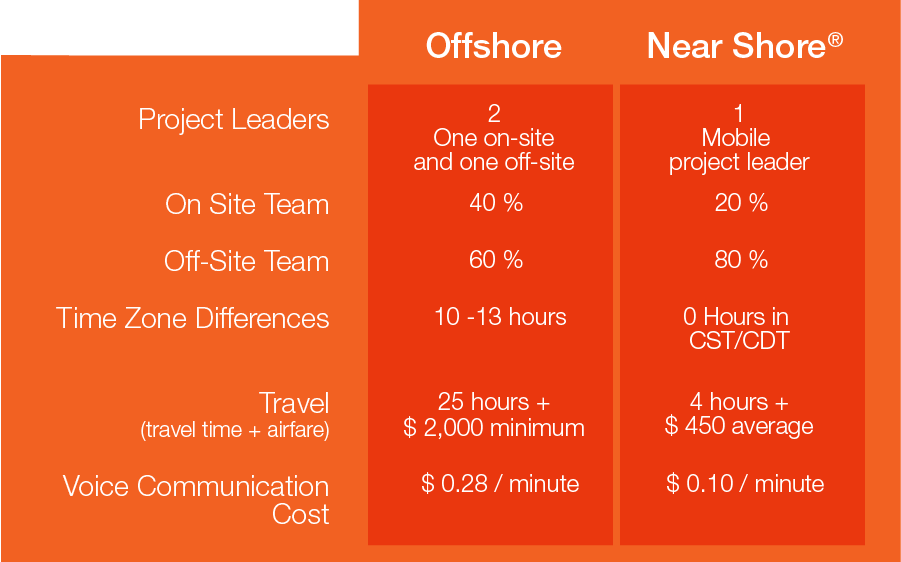 |
What is Nearshore?Nearshore is a form of outsourcing that refers to services deliveredfrom an adjacent or nearby location. |
The concept of nearshore was first coined by Softtek in 1997 as we began to do work with our first U.S. clients. The concept began to gain ground during 2002-2003 as Softtek and the Mexican government began marketing the concept more aggressively. The broad market now identifies Nearshore with primarily Canada and Mexico for the U.S. market. The term has also now evolved to describe any outsourcing location “near” to its primary market (i.e. Eastern European countries to Western European Countries) Some analysts describe it as services delivered from an adjacent or nearby country.
The original concept of Nearshore, as we defined in our white paper, Nearshore Goes Global, essentially promoted the following customer benefits:
These benefits represent the most elemental form of value proposition for a nearshore offering, since they are seemingly available for every company that establishes in a nearshore location, and for a seasoned global sourcing professional can be easily justifiable. Thus, it is understandable to see many players jumping into the nearshore bandwagon and claim the nearshore value proposition.
Softtek has more than 30 offices around the world – 10 of which qualify as Global Delivery Centers, as they comply with the following:
Our network of Global Nearshore Delivery Centers is comprised of the following:

Monterrey
Rated as the #1 city in which to do business in Latin America by Fortune Magazine, Monterrey possesses many attractions. Among the city’s features are:
This city is considered the industrial pole of Mexico, due in part to the presence of approximately 10,000 industries of different specialties that operate in the state: food production, beer, tobacco, glass, cement, plate, steel, chemical products, equipment, and machinery are just some of the most important production areas.
Mexico City
Mexico City is the nation's capital and one of the largest cities in the world. The city owns a modern telecommunications infrastructure composed of thousands of miles of fiber optic cable, copper wire, and wireless. AT&T, MCI, Sprint, and Telmex provide voice and data services with modern infrastructure.
Mexico City is an important hub for airlines from Europe, North and South America. The number of flights to/from the U.S. ranges in the hundreds per day, making the city a very important and accessible business destination.
Aguascalientes
Located halfway between Mexico City and Monterrey, Aguascalientes represents an alternative to people that want to enjoy the infrastructure of a modern city, without the crowds. Being an industrial, mid-size city, Aguascalientes offers excellent power, telecommunication and transportation infrastructure, as well as an important talent pool. The city has an international airport that hosts direct flights from Houston and Dallas.
Baja
Ensenada boasts a protected harbor and modern port facilities, making it Baja California's leading seaport. Located within a 90-minute drive from San Diego, its easy accessibility by land, air or sea travel, have made Ensenada a favorite tourist spot any time of the year.
A Coruña
A Coruña is located in the northwest corner of Spain. A Coruña is in communication to the north of the peninsula with Madrid with diverse Spanish cities along the highway. Additionally, with only a two-hour flight to get to London, A Coruña has three airports in the area:
A Coruña Airport: direct flights to Madrid, Barcelona, Seville, London, Lisbon and Bilbao.
Santiago Airport: direct fights to the majority of the Spanish cities, as well as the main European capitals, such as London, Paris Frankfurt and Rome
Vigo Airport: direct flights to Madrid, Barcelona, Paris
There are three large universities in Galicia that generate more than 1,300 graduates each year. The seven campuses of the Galician cities offer more than seven technical careers.

Proximity and Time Zone
Geographic proximity and similar time-zones allowed companies to have increased face-to-face interaction, allowing more complex types of projects to be done nearshore. This filled a gap left by distant, offshore locations such as India.
Cultural Affinity and Ease of Doing Business
Because of proximity, most nearshore locations have closer cultural affinity to their primary markets than offshore locations. Mexicans for example are very familiar with U.S. lifestyles, customs and styles of communication. In addition, because of NAFTA, Mexico has not only been an important manufacturer and provider of services to the U.S., but is an important market for U.S. businesses. This business exchange has further increased familiarity between the two cultures, helping to minimize communication issues due to cultural differences. In addition, because of NAFTA, visa issues are virtually non-existent as Mexicans can obtain TN visas (renewable 1 year term) easily.
Cost Savings
Depending on the location, cost savings can be equal to that of offshore locations. For example, Mexico was able to give substantial cost savings to U.S customers that were comparable to cost savings in India because indirect costs such as contracting costs, due diligence, communication and travel were lower.
Total Cost of Engagement
Total Cost of Engagement, or TCE, is an approach that evaluates the total expenditures of offshore engagements, bringing to light the cost competitiveness of a mature nearshore model, even when compared to highly cost efficient offshore models.
By using a strong quality model, we build the necessary infrastructure to support work remotely, which even with the benefits of a nearshore location, still represents challenges. The quality model supports our capability to have a very high nearshore leverage (work performed at the low cost facility).